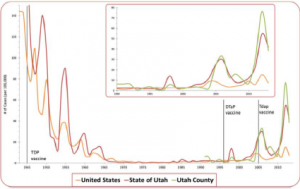Sarah Jones and Beth Luthy, Nursing
Pertussis is a vaccine-preventable disease that has plagued our nation for many years. Since the vaccine’s creation in 1945, rates of pertussis thankfully decreased overall. However, in recent years, due to the decrease in the number of vaccinated individuals, especially adults, pertussis cases have drastically increased, rising by 500% since 2002 (Centers for Disease Control and Prevention [CDC], 2012). For the first time since 1955, the United States has had more than 40,000 cases of pertussis in a single year (CDC, 2012). Even more startling, however, is the fact that Utah County had 76.6 cases per 100,000 people, compared to Utah’s 54.8 and the country’s 13.4 (Bureau of Epidemiology [BE], n.d.; CDC, 2012).
In the average adult, pertussis presents itself as a cold with a cough that lasts for up to 100 days. While highly virulent, pertussis is especially difficult to control because those who are infected are contagious approximately 20 days prior to showing any symptoms, during which they will infect 80% of susceptible household contacts (CDC, 2013, p. 219). Although this disease rarely causes long-term complications in adults, the disease in infants and young children can be devastating. Approximately 80% of infants with pertussis in Utah from 1995-2005 required hospitalization (Utah Bureau of Epidemiology [UBE], n.d.), many of whom needed life support services and, as a result, were at risk for death. Such devastation, however, is completely preventable with a simple vaccination known as Tdap.
In order to protect Utah County infants and young children from the potentially deadly effects of pertussis, an intervention project was conceived in 2013 in cooperation with the Utah County Immunization Coalition, the Utah County Health Department, and the Utah County Immunization Clinic. The project promotes pertussis vaccination among Utah County adults, since most infants and young children contract the communicable disease from a parent, grandparent, or other adult caregiver. The primary goal of the project is to increase the number of adults vaccinated for pertussis, an objective met while working with businesses throughout Utah County to provide vaccine clinics where employees can receive this and other vaccines for little to no cost.
An important aspect of this project is educating those who need the vaccine. Without proper education, many adults are hesitant to receive the vaccines due to possible side effects. We wanted to ensure that every employee in Utah County we encountered had correct information regarding the vaccine so they could make an educated decision. With multiple researchers working on this project, we also realized it was important to standardize the material taught so each person receives the same education. My project focused on standardizing and creating education materials to be used as we approached companies and adults regarding the importance of the Tdap vaccine. I created a flip chart to use when presenting to Human Resources, a PowerPoint to use when education employees in a company, a small booklet to give to employees, and a variety of handouts to be used in addition to the previous information. The information includes a description of symptoms, infectivity, common side effects of the vaccine and how to protect against pertussis. These educational materials were written at a 5th grade level to ensure adults of all backgrounds would be able to understand the information. Materials were also created with illustrations and examples to help those who learn visually to understand the information better. Figure 1 below is an example of a graph we often used showing the rate of increase in Pertussis cases in the country, state, and county.
As a result of these materials being created, we are hoping to see an increase in the number of companies who allow us to bring in an immunization clinic as well as the number of adults who are willing to receive the vaccine. More research needs to be done in the future to determine how effective these new materials are at increasing the number of vaccines given and decreasing the number of cases of pertussis.
References
Bureau of Epidemiology. (n.d.). Historical communicable disease report – Utah. Retrieved from http://health.utah.gov/epi/100yr/100yr.html
Centers for Disease Control and Prevention. (2012). Epidemiology and prevention of vaccine preventable diseases. W. Atkinson, S. Wolfe, & J. Hamborsky (Eds.). Washington DC: Public Health Foundation.
Centers for Disease Control and Prevention. (2013). Surveillance and reporting. Retrieved from http://www.cdc.gov/pertussis/surv-reporting.html
Utah Bureau of Epidemiology. (n.d.). Trends in pertussis activity, Utah 1995-2005. Retrieved from http://health.utah.gov/epi/anrpt/anrpt05/pert_ut_9505_final.pdf

